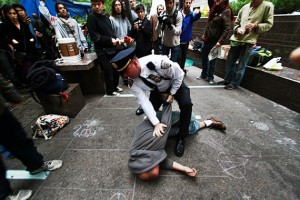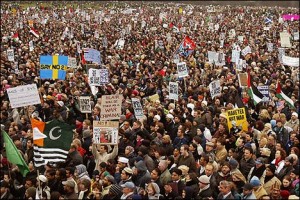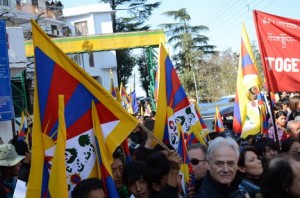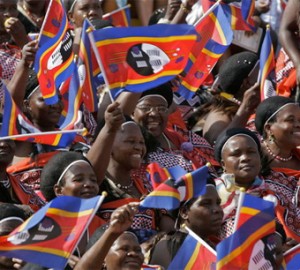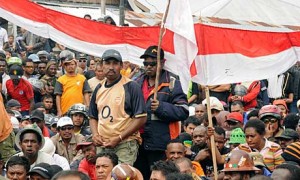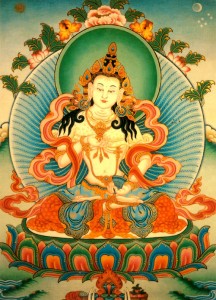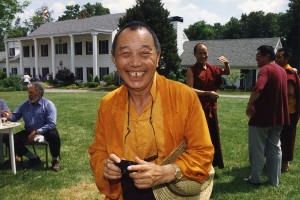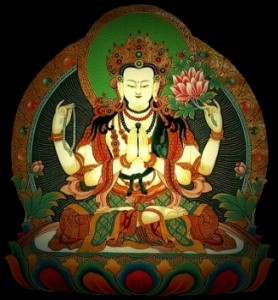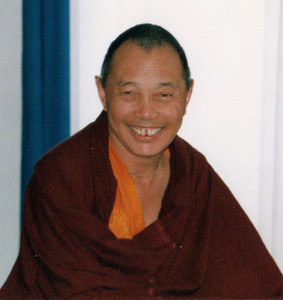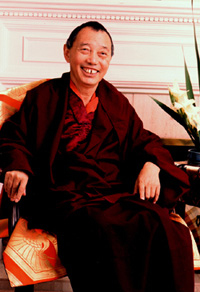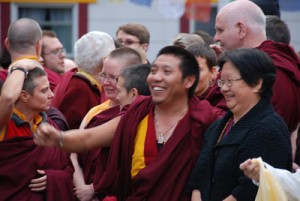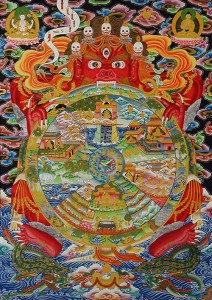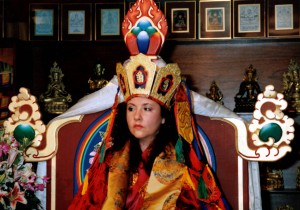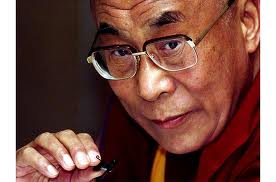
The following is a statement posted by His Holiness the Dalai Lama, reprinted here with permission. To see the original statement click: http://dalailama.com/messages/tibet/reincarnation-statement
24 September 2011
Introduction
My fellow Tibetans, both in and outside Tibet, all those who follow the Tibetan Buddhist tradition, and everyone who has a connection to Tibet and Tibetans: due to the foresight of our ancient kings, ministers and scholar-adepts, the complete teaching of the Buddha, comprising the scriptural and experiential teachings of the Three Vehicles and the Four Sets of Tantra and their related subjects and disciplines flourished widely in the Land of Snow. Tibet has served as a source of Buddhist and related cultural traditions for the world. In particular, it has contributed significantly to the happiness of countless beings in Asia, including those in China, Tibet and Mongolia.
In the course of upholding the Buddhist tradition in Tibet, we evolved a unique Tibetan tradition of recognizing the reincarnations of scholar-adepts that has been of immense help to both the Dharma and sentient beings, particularly to the monastic community.
Since the omniscient Gedun Gyatso was recognized and confirmed as the reincarnation of Gedun Drub in the fifteenth century and the Gaden Phodrang Labrang (the Dalai Lama’s institution) was established, successive reincarnations have been recognized. The third in the line, Sonam Gyatso, was given the title of the Dalai Lama. The Fifth Dalai Lama, Ngawang Lobsang Gyatso, established the Gaden Phodrang Government in 1642, becoming the spiritual and political head of Tibet. For more than 600 years since Gedun Drub, a series of unmistaken reincarnations has been recognised in the lineage of the Dalai Lama.
The Dalai Lamas have functioned as both the political and spiritual leaders of Tibet for 369 years since 1642. I have now voluntarily brought this to an end, proud and satisfied that we can pursue the kind of democratic system of government flourishing elsewhere in the world. In fact, as far back as 1969, I made clear that concerned people should decide whether the Dalai Lama’s reincarnations should continue in the future. However, in the absence of clear guidelines, should the concerned public express a strong wish for the Dalai Lamas to continue, there is an obvious risk of vested political interests misusing the reincarnation system to fulfil their own political agenda. Therefore, while I remain physically and mentally fit, it seems important to me that we draw up clear guidelines to recognise the next Dalai Lama, so that there is no room for doubt or deception. For these guidelines to be fully comprehensible, it is essential to understand the system of Tulku recognition and the basic concepts behind it. Therefore, I shall briefly explain them below.
Past and future lives
In order to accept reincarnation or the reality of Tulkus, we need to accept the existence of past and future lives. Sentient beings come to this present life from their previous lives and take rebirth again after death. This kind of continuous rebirth is accepted by all the ancient Indian spiritual traditions and schools of philosophy, except the Charvakas, who were a materialist movement. Some modern thinkers deny past and future lives on the premise that we cannot see them. Others do not draw such clear cut conclusions on this basis.
Although many religious traditions accept rebirth, they differ in their views of what it is that is reborn, how it is reborn, and how it passes through the transitional period between two lives. Some religious traditions accept the prospect of future life, but reject the idea of past lives.
Generally, Buddhists believe that there is no beginning to birth and that once we achieve liberation from the cycle of existence by overcoming our karma and destructive emotions, we will not be reborn under the sway of these conditions. Therefore, Buddhists believe that there is an end to being reborn as a result of karma and destructive emotions, but most Buddhist philosophical schools do not accept that the mind-stream comes to an end. To reject past and future rebirth would contradict the Buddhist concept of the ground, path and result, which must be explained on the basis of the disciplined or undisciplined mind. If we accept this argument, logically, we would also have to accept that the world and its inhabitants come about without causes and conditions. Therefore, as long as you are a Buddhist, it is necessary to accept past and future rebirth.
For those who remember their past lives, rebirth is a clear experience. However, most ordinary beings forget their past lives as they go through the process of death, intermediate state and rebirth. As past and future rebirths are slightly obscure to them, we need to use evidence-based logic to prove past and future rebirths to them.
There are many different logical arguments given in the words of the Buddha and subsequent commentaries to prove the existence of past and future lives. In brief, they come down to four points: the logic that things are preceded by things of a similar type, the logic that things are preceded by a substantial cause, the logic that the mind has gained familiarity with things in the past, and the logic of having gained experience of things in the past.
Ultimately all these arguments are based on the idea that the nature of the mind, its clarity and awareness, must have clarity and awareness as its substantial cause. It cannot have any other entity such as an inanimate object as its substantial cause. This is self-evident. Through logical analysis we infer that a new stream of clarity and awareness cannot come about without causes or from unrelated causes. While we observe that mind cannot be produced in a laboratory, we also infer that nothing can eliminate the continuity of subtle clarity and awareness.
As far as I know, no modern psychologist, physicist, or neuroscientist has been able to observe or predict the production of mind either from matter or without cause.
There are people who can remember their immediate past life or even many past lives, as well as being able to recognise places and relatives from those lives. This is not just something that happened in the past. Even today there are many people in the East and West, who can recall incidents and experiences from their past lives. Denying this is not an honest and impartial way of doing research, because it runs counter to this evidence. The Tibetan system of recognising reincarnations is an authentic mode of investigation based on people’s recollection of their past lives.
How rebirth takes place
There are two ways in which someone can take rebirth after death: rebirth under the sway of karma and destructive emotions and rebirth through the power of compassion and prayer. Regarding the first, due to ignorance negative and positive karma are created and their imprints remain on the consciousness. These are reactivated through craving and grasping, propelling us into the next life. We then take rebirth involuntarily in higher or lower realms. This is the way ordinary beings circle incessantly through existence like the turning of a wheel. Even under such circumstances ordinary beings can engage diligently with a positive aspiration in virtuous practices in their day-to-day lives. They familiarise themselves with virtue that at the time of death can be reactivated providing the means for them to take rebirth in a higher realm of existence. On the other hand, superior Bodhisattvas, who have attained the path of seeing, are not reborn through the force of their karma and destructive emotions, but due to the power of their compassion for sentient beings and based on their prayers to benefit others. They are able to choose their place and time of birth as well as their future parents. Such a rebirth, which is solely for the benefit of others, is rebirth through the force of compassion and prayer.
The meaning of Tulku
It seems the Tibetan custom of applying the epithet ‘Tulku’ (Buddha’s Emanation Body) to recognized reincarnations began when devotees used it as an honorary title, but it has since become a common expression. In general, the term Tulku refers to a particular aspect of the Buddha, one of the three or four described in the Sutra Vehicle. According to this explanation of these aspects of the Buddha, a person who is totally bound by destructive emotions and karma has the potential to achieve the Truth Body (Dharmakaya), comprising the Wisdom Truth Body and Nature Truth Body. The former refers to the enlightened mind of a Buddha, which sees everything directly and precisely, as it is, in an instant. It has been cleared of all destructive emotions, as well as their imprints, through the accumulation of merit and wisdom over a long period of time. The latter, the Nature Truth Body, refers to the empty nature of that all-knowing enlightened mind. These two together are aspects of the Buddhas for themselves. However, as they are not directly accessible to others, but only amongst the Buddhas themselves, it is imperative that the Buddhas manifest in physical forms that are accessible to sentient beings in order to help them. Hence, the ultimate physical aspect of a Buddha is the Body of Complete Enjoyment (Sambhogakaya), which is accessible to superior Bodhisattvas, and has five definite qualifications such as residing in the Akanishta Heaven. And from the Body of Complete Enjoyment are manifested the myriad Emanation Bodies or Tulkus (Nirmanakaya), of the Buddhas, which appear as gods or humans and are accessible even to ordinary beings. These two physical aspects of the Buddha are termed Form Bodies, which are meant for others.
The Emanation Body is three-fold: a) the Supreme Emanation Body like Shakyamuni Buddha, the historical Buddha, who manifested the twelve deeds of a Buddha such as being born in the place he chose and so forth; b) the Artistic Emanation Body which serves others by appearing as craftsmen, artists and so on; and c) the Incarnate Emanation Body, according to which Buddhas appear in various forms such as human beings, deities, rivers, bridges, medicinal plants, and trees to help sentient beings. Of these three types of Emanation Body, the reincarnations of spiritual masters recognized and known as ‘Tulkus’ in Tibet come under the third category. Among these Tulkus there may be many who are truly qualified Incarnate Emanation Bodies of the Buddhas, but this does not necessarily apply to all of them. Amongst the Tulkus of Tibet there may be those who are reincarnations of superior Bodhisattvas, Bodhisattvas on the paths of accumulation and preparation, as well as masters who are evidently yet to enter these Bodhisattva paths. Therefore, the title of Tulku is given to reincarnate Lamas either on the grounds of their resembling enlightened beings or through their connection to certain qualities of enlightened beings.
As Jamyang Khyentse Wangpo said:
“Reincarnation is what happens when someone takes rebirth after the predecessor’s passing away; emanation is when manifestations take place without the source’s passing away.”
Recognition of Reincarnations
The practice of recognizing who is who by identifying someone’s previous life occurred even when Shakyamuni Buddha himself was alive. Many accounts are found in the four Agama Sections of the Vinaya Pitaka, the Jataka Stories, the Sutra of the Wise and Foolish, the Sutra of One Hundred Karmas and so on, in which the Tathagata revealed the workings of karma, recounting innumerable stories about how the effects of certain karmas created in a past life are experienced by a person in his or her present life. Also, in the life stories of Indian masters, who lived after the Buddha, many reveal their previous places of birth. There are many such stories, but the system of recognizing and numbering their reincarnations did not occur in India.
The system of recognizing reincarnations in Tibet
Past and future lives were asserted in the indigenous Tibetan Bon tradition before the arrival of Buddhism. And since the spread of Buddhism in Tibet, virtually all Tibetans have believed in past and future lives. Investigating the reincarnations of many spiritual masters who upheld the Dharma, as well as the custom of praying devotedly to them, flourished everywhere in Tibet. Many authentic scriptures, indigenous Tibetan books such as the Mani Kabum and the Fivefold Kathang Teachings and others like the The Books of Kadam Disciples and the Jewel Garland: Responses to Queries, which were recounted by the glorious, incomparable Indian master Dipankara Atisha in the 11th century in Tibet, tell stories of the reincarnations of Arya Avalokiteshvara, the Bodhisattva of compassion. However, the present tradition of formally recognizing the reincarnations of masters first began in the early 13th century with the recognition of Karmapa Pagshi as the reincarnation of Karmapa Dusum Khyenpa by his disciples in accordance with his prediction. Since then, there have been seventeen Karmapa incarnations over more than nine hundred years. Similarly, since the recognition of Kunga Sangmo as the reincarnation of Khandro Choekyi Dronme in the 15th century there have been more than ten incarnations of Samding Dorje Phagmo. So, among the Tulkus recognized in Tibet there are monastics and lay tantric practitioners, male and female. This system of recognizing the reincarnations gradually spread to other Tibetan Buddhist traditions, and Bon, in Tibet. Today, there are recognized Tulkus in all the Tibetan Buddhist traditions, the Sakya, Geluk, Kagyu and Nyingma, as well as Jonang and Bodong, who serve the Dharma. It is also evident that amongst these Tulkus some are a disgrace.
The omniscient Gedun Drub, who was a direct disciple of Je Tsongkhapa, founded Tashi Lhunpo Monastery in Tsang and took care of his students. He passed away in 1474 at the age of 84. Although initially no efforts were made to identify his reincarnation, people were obliged to recognize a child named Sangye Chophel, who had been born in Tanak, Tsang (1476), because of what he had to say about his amazing and flawless recollections of his past life. Since then, a tradition began of searching for and recognizing the successive reincarnations of the Dalai Lamas by the Gaden Phodrang Labrang and later the Gaden Phodrang Government.
The ways of recognizing reincarnations
After the system of recognizing Tulkus came into being, various procedures for going about it began to develop and grow. Among these some of the most important involve the predecessor’s predictive letter and other instructions and indications that might occur; the reincarnation’s reliably recounting his previous life and speaking about it; identifying possessions belonging to the predecessor and recognizing people who had been close to him. Apart from these, additional methods include asking reliable spiritual masters for their divination as well as seeking the predictions of mundane oracles, who appear through mediums in trance, and observing the visions that manifest in sacred lakes of protectors like Lhamoi Latso, a sacred lake south of Lhasa.
When there happens to be more than one prospective candidate for recognition as a Tulku, and it becomes difficult to decide, there is a practice of making the final decision by divination employing the dough-ball method (zen tak) before a sacred image while calling upon the power of truth.
Emanation before the passing away of the predecessor (ma-dhey tulku)
Usually a reincarnation has to be someone’s taking rebirth as a human being after previously passing away. Ordinary sentient beings generally cannot manifest an emanation before death (ma-dhey tulku), but superior Bodhisattvas, who can manifest themselves in hundreds or thousands of bodies simultaneously, can manifest an emanation before death. Within the Tibetan system of recognizing Tulkus there are emanations who belong to the same mind-stream as the predecessor, emanations who are connected to others through the power of karma and prayers, and emanations who come as a result of blessings and appointment.
The main purpose of the appearance of a reincarnation is to continue the predecessor’s unfinished work to serve Dharma and beings. In the case of a Lama who is an ordinary being, instead of having a reincarnation belonging to the same mind-stream, someone else with connections to that Lama through pure karma and prayers may be recognized as his or her emanation. Alternatively it is possible for the Lama to appoint a successor who is either his disciple or someone young who is to be recognized as his emanation. Since these options are possible in the case of an ordinary being, an emanation before death that is not of the same mind-stream is feasible. In some cases one high Lama may have several reincarnations simultaneously, such as incarnations of body, speech and mind and so on. In recent times, there have been well-known emanations before death such as Dudjom Jigdral Yeshe Dorje and Chogye Trichen Ngawang Khyenrab.
Using the Golden Urn
As the degenerate age gets worse, and as more reincarnations of high Lamas are being recognized, some of them for political motives, increasing numbers have been recognized through inappropriate and questionable means, as a result of which huge damage has been done to the Dharma.
During the conflict between Tibet and the Gurkhas (1791-93) the Tibetan Government had to call on Manchu military support. Consequently the Gurkha military was expelled from Tibet, but afterwards Manchu officials made a 29-point proposal on the pretext of making the Tibetan Government’s administration more efficient. This proposal included the suggestion of picking lots from a Golden Urn to decide on the recognition of the reincarnations of the Dalai Lamas, Panchen Lamas and Hutuktus, a Mongolian title given to high Lamas. Therefore, this procedure was followed in the case of recognizing some reincarnations of the Dalai Lama, Panchen Lama and other high Lamas. The ritual to be followed was written by the Eighth Dalai Lama Jampel Gyatso. Even after such a system had been introduced, this procedure was dispensed with for the Ninth, Thirteenth and myself, the Fourteenth Dalai Lama.
Even in the case of the Tenth Dalai Lama, the authentic reincarnation had already been found and in reality this procedure was not followed, but in order to humour the Manchus it was merely announced that this procedure had been observed.
The Golden Urn system was actually used only in the cases of the Eleventh and Twelfth Dalai Lamas. However, the Twelfth Dalai Lama had already been recognized before the procedure was employed. Therefore, there has only been one occasion when a Dalai Lama was recognized by using this method. Likewise, among the reincarnations of the Panchen Lama, apart from the Eighth and the Ninth, there have been no instances of this method being employed. This system was imposed by the Manchus, but Tibetans had no faith in it because it lacked any spiritual quality. However, if it were to be used honestly, it seems that we could consider it as similar to the manner of divination employing the dough-ball method (zen tak).
In 1880, during the recognition of the Thirteenth Dalai Lama as the reincarnation of the Twelfth, traces of the Priest-Patron relationship between Tibet and the Manchus still existed. He was recognized as the unmistaken reincarnation by the Eighth Panchen Lama, the predictions of the Nechung and Samye oracles and by observing visions that appeared in Lhamoi Latso, therefore the Golden Urn procedure was not followed. This can be clearly understood from the Thirteenth Dalai Lama’s final testament of the Water-Monkey Year (1933) in which he states:
“As you all know, I was selected not in the customary way of picking lots from the golden urn, but my selection was foretold and divined. In accordance with these divinations and prophecies I was recognized as the reincarnation of the Dalai Lama and enthroned.”
When I was recognized as the Fourteenth incarnation of the Dalai Lama in 1939, the Priest-Patron relationship between Tibet and China had already come to an end. Therefore, there was no question of any need to confirm the reincarnation by employing the Golden Urn. It is well-known that the then Regent of Tibet and the Tibetan National Assembly had followed the procedure for recognizing the Dalai Lama’s reincarnation taking account of the predictions of high Lamas, oracles and the visions seen in Lhamoi Latso; the Chinese had no involvement in it whatever. Nevertheless, some concerned officials of the Guomintang later cunningly spread lies in the newspapers claiming that they had agreed to forego the use of the Golden Urn and that Wu Chung-tsin presided over my enthronement, and so on. This lie was exposed by Ngabo Ngawang Jigme, the Vice-Chairman of the Standing Committee of the National People’s Congress, who the People’s Republic of China considered to be a most progressive person, at the Second Session of the Fifth People’s Congress of the Tibet Autonomous Region (31st July 1989). This is clear, when, at the end of his speech, in which he gave a detailed explanation of events and presented documentary evidence, he demanded:
“What need is there for the Communist Party to follow suit and continue the lies of the Guomintang?”
Deceptive strategy and false hopes
In the recent past, there have been cases of irresponsible managers of wealthy Lama-estates who indulged in improper methods to recognize reincarnations, which have undermined the Dharma, the monastic community and our society. Moreover, since the Manchu era Chinese political authorities repeatedly engaged in various deceitful means using Buddhism, Buddhist masters and Tulkus as tools to fulfil their political ends as they involved themselves in Tibetan and Mongolian affairs. Today, the authoritarian rulers of the People’s Republic of China, who as communists reject religion, but still involve themselves in religious affairs, have imposed a so-called re-education campaign and declared the so-called Order No. Five, concerning the control and recognition of reincarnations, which came into force on 1st September 2007. This is outrageous and disgraceful. The enforcement of various inappropriate methods for recognizing reincarnations to eradicate our unique Tibetan cultural traditions is doing damage that will be difficult to repair.
Moreover, they say they are waiting for my death and will recognize a Fifteenth Dalai Lama of their choice. It is clear from their recent rules and regulations and subsequent declarations that they have a detailed strategy to deceive Tibetans, followers of the Tibetan Buddhist tradition and the world community. Therefore, as I have a responsibility to protect the Dharma and sentient beings and counter such detrimental schemes, I make the following declaration.
The next incarnation of the Dalai Lama
As I mentioned earlier, reincarnation is a phenomenon which should take place either through the voluntary choice of the concerned person or at least on the strength of his or her karma, merit and prayers. Therefore, the person who reincarnates has sole legitimate authority over where and how he or she takes rebirth and how that reincarnation is to be recognized. It is a reality that no one else can force the person concerned, or manipulate him or her. It is particularly inappropriate for Chinese communists, who explicitly reject even the idea of past and future lives, let alone the concept of reincarnate Tulkus, to meddle in the system of reincarnation and especially the reincarnations of the Dalai Lamas and Panchen Lamas. Such brazen meddling contradicts their own political ideology and reveals their double standards. Should this situation continue in the future, it will be impossible for Tibetans and those who follow the Tibetan Buddhist tradition to acknowledge or accept it.
When I am about ninety I will consult the high Lamas of the Tibetan Buddhist traditions, the Tibetan public, and other concerned people who follow Tibetan Buddhism, and re-evaluate whether the institution of the Dalai Lama should continue or not. On that basis we will take a decision. If it is decided that the reincarnation of the Dalai Lama should continue and there is a need for the Fifteenth Dalai Lama to be recognized, responsibility for doing so will primarily rest on the concerned officers of the Dalai Lama’s Gaden Phodrang Trust. They should consult the various heads of the Tibetan Buddhist traditions and the reliable oath-bound Dharma Protectors who are linked inseparably to the lineage of the Dalai Lamas. They should seek advice and direction from these concerned beings and carry out the procedures of search and recognition in accordance with past tradition. I shall leave clear written instructions about this. Bear in mind that, apart from the reincarnation recognized through such legitimate methods, no recognition or acceptance should be given to a candidate chosen for political ends by anyone, including those in the People’s Republic of China.
The Dalai Lama
Dharamsala
(Translated from the Tibetan)



